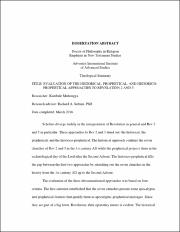| dc.contributor.author | Muhongya, Kambale | |
| dc.date.accessioned | 2021-07-26T01:48:47Z | |
| dc.date.available | 2021-07-26T01:48:47Z | |
| dc.date.issued | 2016-03 | |
| dc.identifier.uri | https://dspace.aiias.edu/xmlui/handle/20.500.12977/440 | |
| dc.description | Unpublished Dissertation (PhD Religion)
Shelf Location: BS1556 .M64 2016 ATDC | en_US |
| dc.description.abstract | Scholars diverge widely in the interpretation of Revelation in general and Rev 2
and 3 in particular. Three approaches to Rev 2 and 3 stand out: the historical, the
prophetical, and the historico-prophetical. The historical approach confines the seven
churches of Rev 2 and 3 in the 1st century AD while the prophetical projects them in the
eschatological day of the Lord after the Second Advent. The historico-prophetical fills
the gap between the first two approaches by stretching out the seven churches in the
history from the 1st century AD up to the Second Advent.
The evaluation of the three abovementioned approaches was based on four
criteria. The first criterion established that the seven churches present some apocalyptic
and prophetical features that qualify them as apocalyptic-prophetical messages. Since
they are part of a big letter, Revelation, their epistolary nature is evident. The historical
approach emphasizes the epistolary character of the seven churches but overlooks their
apocalyptic-prophetical nature. By contrast, the prophetical approach emphasizes the
apocalyptic-prophetical nature of the seven churches but overlooks their epistolary
character. Only the historico-prophetical approach recognizes both the apocalypticprophetical and the epistolary nature of the seven churches and meets criterion 1.
The second criterion demonstrated connectedness between the seven churches and
the rest of Revelation. It revealed that (1) Rev 3:21 constitutes an interlock between the
seven churches and the two throne scenes in Rev 4:1-8:1 and Rev 19:1-21:4; (2) in the
chiastic structure the seven churches (church militant) correspond to the church
triumphant of Rev 21 and 22; and (3) in the marriage covenant structure the bride
betrothed in Rev 1-3 (seven churches) is the same that prepares herself in Rev 4-18 for
her wedding with the Lamb that happens in Rev 19 followed by a honeymoon in Rev 20
and eternal settlement in Rev 21-22. The historical and the prophetical approaches that
confine the seven churches respectively in the 1st century AD and in the time of the end
fail to perceive such a progression that only the historico-prophetical approach notices
and so meets criterion 2.
The third criterion discussed Rev 1:1; Rev 1:19; and Rev 4:1b. It demonstrated a
double application of the seven messages made clear in the study of the time marker µετὰ
ταῦτα (after these things) in connection with γίνοµαι (to take place) in the discourse of
the One called the Alpha and the Omega that climaxes with γέγοναν (they have taken
place) in Rev 21:6. Both the historical and the prophetical approaches fail to perceive this
principle of double application. Only the historico-prophetical approach points it out and
so meets criterion 3 | en_US |
| dc.language.iso | en_US | en_US |
| dc.publisher | Adventist International Institute of Advanced Studies | en_US |
| dc.subject | Bible. -- .N.T. -- Revelation -- Prophecies. | en_US |
| dc.subject | Bible. -- .N.T. -- Revelation -- Criticism, interpretaion,etc. | en_US |
| dc.subject | Bible. -- .N.T. -- Revelation. -- II-III -- Criticism, interpretaion,etc. | en_US |
| dc.title | Evaluation of the historical, prophetical, and historico-prophetical approaches to Revelation 2 and 3 | en_US |
| dc.type | Dissertation | en_US |

